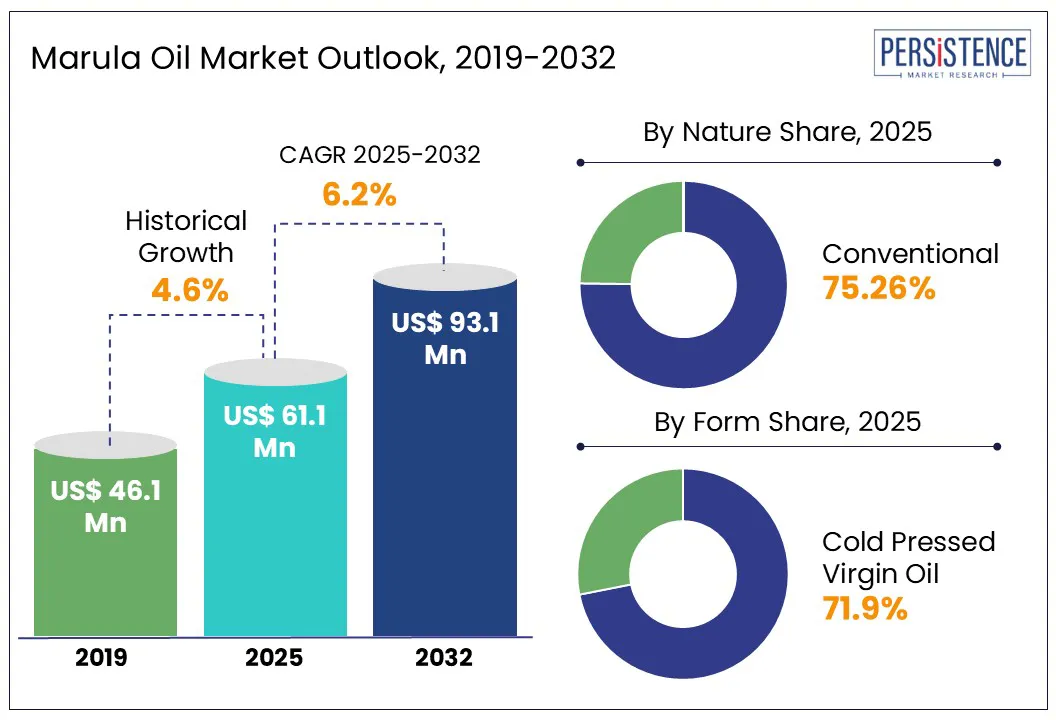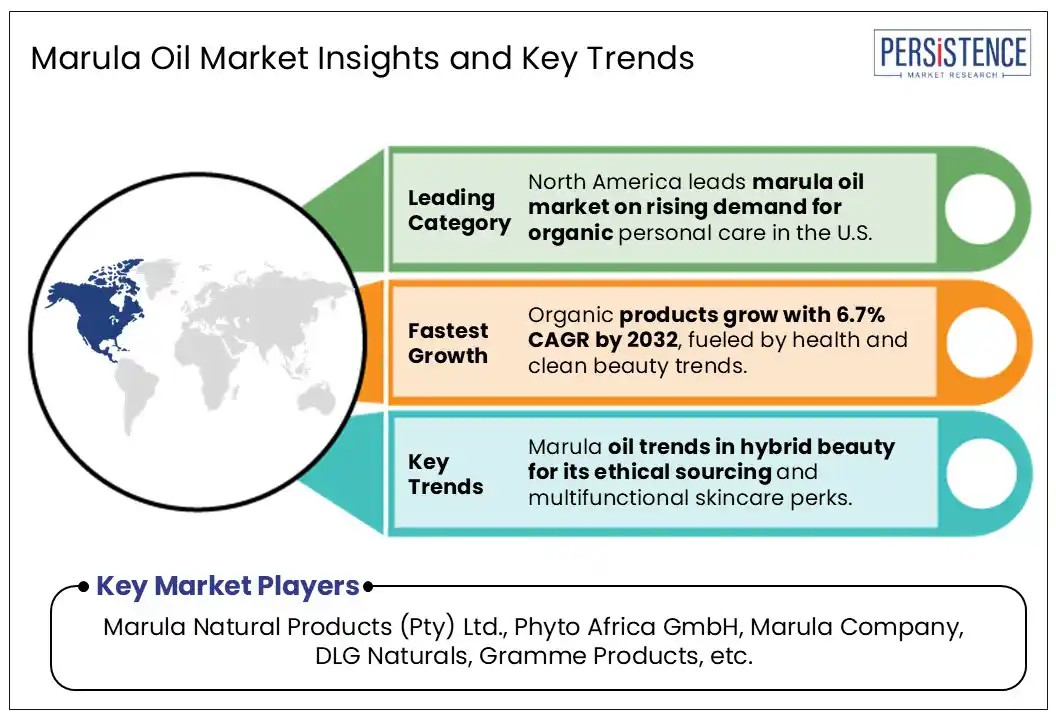ID: PMRREP30359| 198 Pages | 20 Jun 2025 | Format: PDF, Excel, PPT* | Food and Beverages

The global marula oil market size is likely to be valued US$61.1 million in 2025 and is estimated to reach US$93.1 million by 2032, and grow a CAGR of 6.2% for the forecast period 2025 - 2032.
Marula oil has traditionally in Southern Africa for cooking and meat preservation due to its rich antioxidant content. It offers a natural alternative to olive oil, boasting a higher antioxidant content. Despite its benefits, global use of marula oil as a cooking oil remains limited, with most demand currently concentrated in the cosmetics and personal care sectors, where it serves as a key ingredient due to its nourishing qualities.
Recent research also points to its potential use in physiotherapy, expanding its range of applications. Its versatility, combined with stable characteristics is contributing to its growing appeal in both regional and global markets. While demand is strong in established regions such as Europe, emerging markets, especially in Asia Pacific, are expected to show increased adoption of marula oil across different industries over the coming years, driven by its multi-functional benefits and expanding awareness of natural and organic products.

Key Industry Highlights:
|
Global Market Attribute |
Key Insights |
|
Marula Oil Market Size (2025E) |
US$ 61.1 Mn |
|
Market Value Forecast (2032F) |
US$ 93.1 Mn |
|
Projected Growth (CAGR 2025 to 2032) |
6.2% |
|
Historical Market Growth (CAGR 2019 to 2024) |
4.6% |
Naturally obtained marula oil, derived from the kernels and nuts of marula fruit is bound to be a potential ingredient due to its versatility, light texture, and beautifying benefits for the cosmetics manufacturing industries. It contains a considerable amount of fatty acids and 60% antioxidants over any other oil, which accounts for its anti-aging and sun damage prevention properties.
It also has antimicrobial properties, making it ideal for repairing irritated and acne-prone skin. The health benefits offered by the oil include reducing dryness, irritation, and inflammation. It can be applied directly to the face, hair, and nails or used in shampoos, hair conditioners, moisturizers, skin lotions, and nail treatments. All these benefits certainly increase the use of marula oil in various end-use industrial products.
The primary element is the seasonality of the marula fruit, from which the oil is extracted through the kernels. The fruit may be harvested for around two to three months, and the rest of the year, there is a clear need for the nuts produced during the harvesting season. The amplified demand, along with the restrictions and supply chain, is all aiding in the growing cost of marula oil.
Moreover, the fruit is also prone to various natural calamities and diseases, which hinder the supply of marula oil to a great extent. Furthermore, the market is less commercialized and requires immediate attention. The marula harvesting and cultivation sector is not organized enough to be considered viable for commercialization. The over-reliance of marula oil producers on manual labor for harvesting, drying, and sometimes even de-nutting has slowed down the commercialization pace to a considerable moderate, which must have been fast considering the overall increasing demand for the use of marula oil in various end-use industries.
The use of marula oil as an edible oil is becoming popular since its inception. But it is majorly used for dietary purposes in the African marketplace. Southern African countries such as Namibia, Botswana, and Zimbabwe are among the top consumers of marula oil. But the acceptability of marula oil in global markets is not high due to several factors, such as less reliance on scientific data and commercialization. However, if these hurdles are overcome with an added compliance for food safety and other regulations, the marula oil market seems to have an optimistic growth outlook in the long-term. The fact that it can be a potential competitor to olive oil helps in the overall development.
The conventional segment accounts as the largest share in the marula oil market, primarily due to its widespread availability and cost-effectiveness. Conventional marula oil is more accessible to manufacturers, especially in regions where organic certification processes can be complex or expensive. Producers often prefer conventional marula oil for bulk production, particularly in the cosmetics and personal care industry, where high-volume sourcing is essential.
Additionally, many small-scale farmers continue to use traditional cultivation methods, contributing to the steady supply of conventional oil. The segment’s dominance is also supported by strong demand in emerging economies where price-sensitive consumers drive market preferences.
The cold pressed virgin oil market has a majority share of 71.9% in 2025, by type segment. The oil processors are providing marula oil according to the standard benchmarks set by various end-use industries. If one type is suitable for personal care and cosmetics industries, the other is suitable for an edible grade. Different manufacturers of products want their oils to be either cold pressed virgin or cold pressed and depending upon the requirements the oil processors are providing different types of marula oil.
For instance, manufacturers prefer to refine their oil according to their refining processes and hence in such instances unrefined or cold pressed oil is provided to them. It provides a customization opportunity for end-users and offers optimistic business growth opportunity to oil processors.

North America, particularly the U.S., stands out as a major consumer of marula oil, driven by the region's strong demand for cosmetics and personal care products made with natural ingredients. Consumers in this region are highly informed and show a strong preference for clean-label, plant-derived formulations that align with health-conscious lifestyles. Marula oil, known for its nourishing and antioxidant-rich profile, fits perfectly into a wide range of skincare and body care applications.
The U.S. leads the global marula oil market. Its dominance is further supported by the presence of established beauty brands and manufacturers that are actively incorporating marula oil into their product lines to meet growing consumer demand. The rising trend of using premium, multifunctional oils in personal care has made marula oil a popular choice, further fueling market expansion across the North American region.
Europe represents a significant market for marula oil, driven by its strong presence in the personal care and cosmetics industry. Among European nations, France stands out as a particularly lucrative market. It accounts for approximately 16.6% regional share in 2025, France is home to major global cosmetic brands such as L’Oréal Paris, which actively incorporates marula oil into their product lines due to its high antioxidant content and perceived premium value.
Marula oil-based formulations are increasingly favored over those without, leading to greater demand among European consumers seeking natural, high-performance ingredients. The growing shift toward clean beauty, sustainability, and natural product preferences is further pushing manufacturers to include marula oil in personal and body care applications. As industries across Europe continue to align with evolving consumer trends, the marula oil market in the region is expected to grow steadily, with France alone projected to expand at a CAGR of 3.8% in the coming years.
The global marula oil market players are looking forward to international collaborations and long-term business agreements to strengthen the supply of natural marula oil major personal care & cosmetics products manufacturers. These partnerships are aimed at benefiting financially and collaborative research & development.
The global market is estimated to increase from US$ 61.1 million in 2025 to US$ 93.1 million in 2032.
Rising demand for natural skincare, anti-aging solutions, and sustainable beauty products fuels the global marula oil market growth.
The market is projected to record a CAGR of 6.2% during the forecast period from 2025 to 2032.
Marula Natural Products (Pty) Ltd., Phyto Africa GmbH, Marula Company, DLG Naturals, and Gramme Products are a few of the leading manufacturers in the market.
Expanding use in edible oils, wellness applications, and increasing adoption in Asia-Pacific create strong opportunities for marula oil market expansion.
|
Report Attribute |
Details |
|
Historical Data/Actuals |
2019 - 2024 |
|
Forecast Period |
2025 - 2032 |
|
Market Analysis Units |
Value: US$ Mn, Volume: As applicable |
|
Geographical Coverage |
|
|
Segmental Coverage |
|
|
Competitive Analysis |
|
|
Report Highlights |
|
|
Customization and Pricing |
Available upon request |
By Nature
By Form
By End-user
By Distribution Channel
By Region
Delivery Timelines
For more information on this report and its delivery timelines please get in touch with our sales team.
About Author